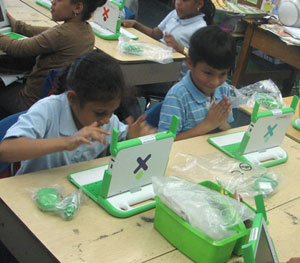The KAPPA pilot is now two months old, and we’re taking inventory on what was accomplished, what works and what doesn’t. I’ll break this all out into two areas (1) Teaching and Learning (2) Hardware / Software.
Teaching and Learning
There was a lot of excitement when the devices were first introduced. It took approximately a week for the class to acclimate to using the devices in everyday work. However, after two months, the students are still very excited about the devices.
On the instruction end, the class participated in Writing Matters: Response to Literature – a technology infused writing unit that has online resources, Moodle activities, blogging and animations. We found that because this was a new unit of instruction for the teacher (Mr. Almazar) that Mr. Almazar wanted to keep consistency with his other classrooms (that did not have XO’s). As a result, most of the Moodle activities were not used. Because of the infusion of hardware and the change in curriculum (to one that takes advantage of technology), there was a definite learning curve for Mr. Almanzar acclimating to changing his instruction and becoming comfortable using the 1:1 environment in an effective way. The next unit of instruction is poetry (a unit he is familiar with) – and he is confident that they will take full advantage of Moodle and the online unit.
Hardware / Software
In the two months we have seen 3 out of 28 (~11%) devices “break” to the point where outside support is needed to repair them:
- A cracked screen (mostly likely the student dropped the XO on a corner)
- A broken keyboard (might be software, might be user-related)
- A OS boot “not found” (most likely software related and fixable)
Students do take the XO’s home regularly – and are excited when they can, and we have found it to be a very effective classroom management (threat) tool. No power adapters have been lost / broken. Students charge their devices using power strip “squids” under their tables. Initially there was a learning curve for students – they complained that the OS booted slowly, and were “thrown off” by the lack of icons on the write activity. Since then, they all feel the write activity is much easier to use than MS Word and prefer the journal method of storage over the saving dialogs on Windows and Mac.
In terms of internet access, the workaround for the DOE internet we implemented gets them online, but is annoying to have to restart every time they want to “share.” Also, students do not have internet access at home for the most part and will not go to cafes or libraries. Mr. Almazar relied on print handouts largely for this reason. The 800 x 600 resolution was a problem – they weren’t aware that you can “shrink” the page to fit. Flash wasn’t properly installed on a couple devices initially in the first week. And pop-ups were an issue that needed a work-around. Also, the students could not all watch learning animations in class because the sound of 30 devices at once was a problem. Inserting and managing images in the write activity is still a problem – it is not clear how to insert images from the web.
All in all, everyone agrees it has been a huge success so far, and is a very effective and easy to use tool. The above issues are all relatively small compared to the improvement in teaching and learning that is happening. We have found though, that real-classroom-situations do not change just because of technology immersion. There has to be buy in from the teacher, and the school should be prepared to offer teachers a high level of support. Otherwise, the technology does not make it’s way into the curriculum and instruction.
As a foot-note, all this information is coming from the Teaching Matters professional developer who has been (and is) working in-class with the students and teacher.
Up next – a formal assessment!
Read Full Post »


